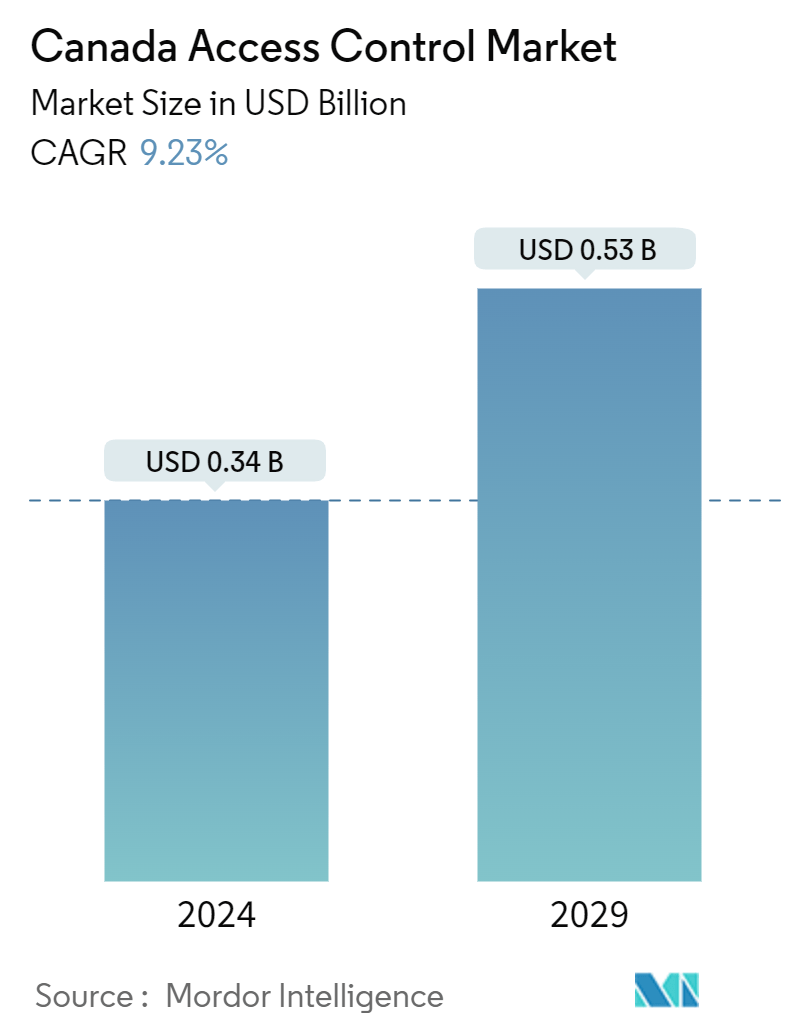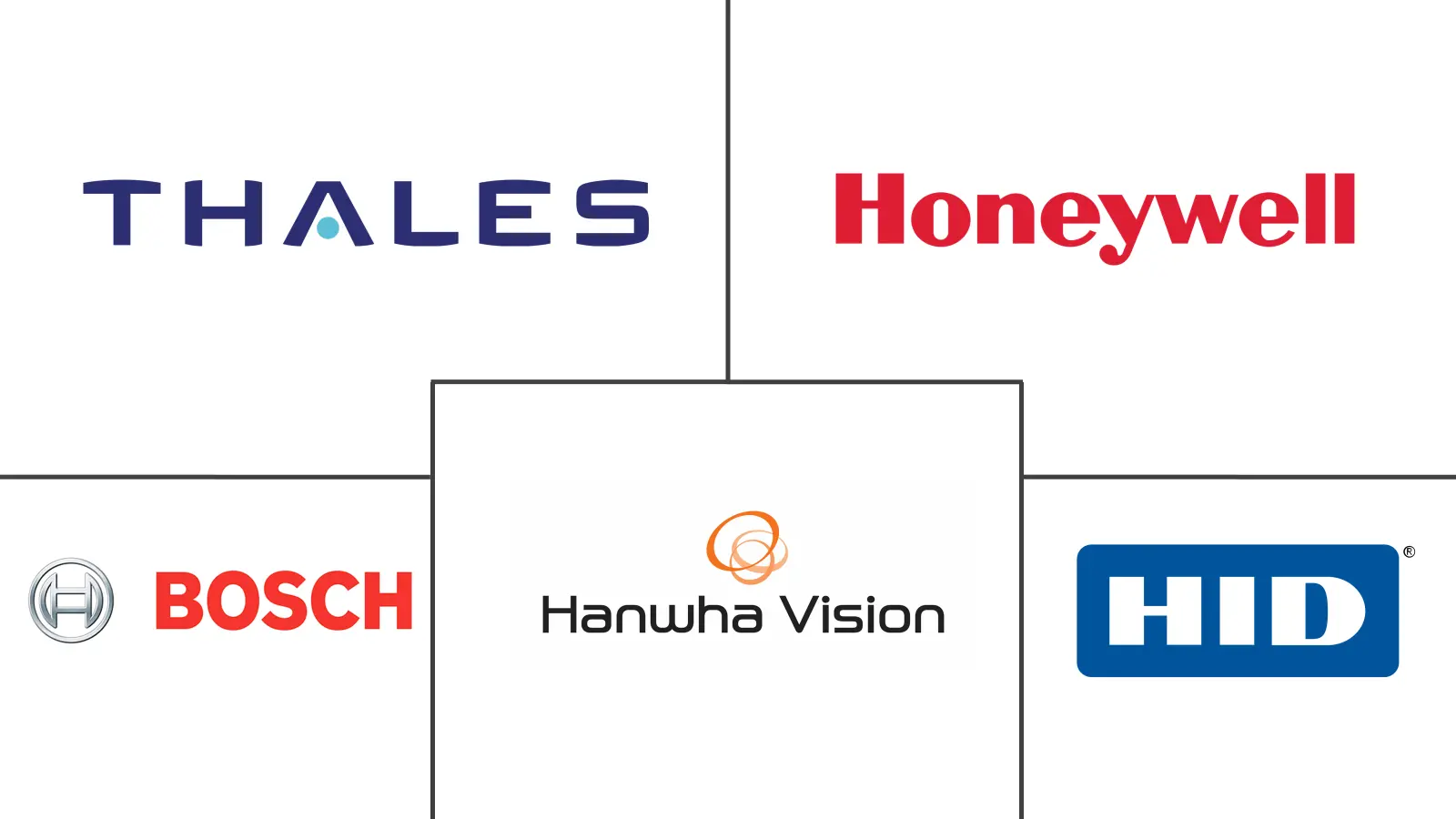Market Size of Canada Access Control Industry

| Study Period | 2019 - 2029 |
| Base Year For Estimation | 2023 |
| Market Size (2024) | USD 0.34 Billion |
| Market Size (2029) | USD 0.53 Billion |
| CAGR (2024 - 2029) | 9.23 % |
| Market Concentration | Low |
Major Players
*Disclaimer: Major Players sorted in no particular order |
Canada Access Control Market Analysis
The Canada Access Control Market size is estimated at USD 0.34 billion in 2024, and is expected to reach USD 0.53 billion by 2029, growing at a CAGR of 9.23% during the forecast period (2024-2029).
- The market for access control is witnessing growth in Canada owing to increasing security concerns, technological advancement, regulatory compliance, and smart building initiatives. Moreover, as businesses increasingly recognize the importance of securing their premises and protecting sensitive information, the corporate sector is investing more in advanced access control devices to ensure that only authorized personnel can access certain areas.
- Access control is an electronic system that allows authorized personnel to enter restricted, controlled, or secure spaces by presenting an access card to a credential reader. Organizations use access control systems that depend on access card readers, user credentials, auditing, and reports to track employee access to controlled business locations and proprietary areas, such as data centers, to secure a facility. Some of these systems include access control panels to restrict entry to rooms and buildings, alarms, and lockdown capabilities to stop unauthorized access or operations.
- The Internet of Things (IoT) has increased the efficiency and standard of automation systems by enabling secure data exchange and tying smart objects to the Internet. Cloud-based communication between connected security systems and devices makes remote monitoring of critical areas possible. Using password authentication to thwart hacking makes IoT-based security systems secure. Because IoT can be used in various solutions, such as smart alarm systems and garage door openers, it is replacing many businesses' traditional processes.
- Moreover, the increasing government investments toward infrastructural developments are expected to boost the demand for access control solutions in the country during the forecast period. Some such projects in the country include Ottawa Civic Hospital, Windsor Acute Care Regional Hospital, an extension of the blue line of the Montreal Subway Network and construction of subway stations, and expansion of the international airport in Saint Laurent, among others.
- According to a recent article in Drug Diversion Digest, hospitals, medical institutions, ambulance services, long-term care facilities, and pharmacies accounted for over 70% of prescription tampering, fraud, and theft. Several hospitals are using access control systems to reduce these dangers. Hospitals can lower the risk of abuse or theft by digital monitoring and restricting access to medication cabinets and dispensaries. Genetec is a Canadian company helping the healthcare industry of Canada to prevent this.
- The Canadian government is using biometrics increasingly. For instance, iris scans are utilized in the CANPASS and NEXUS border clearance programs, fingerprints and iris scans are used to limit entry to secure airport areas, and digitized face pictures for electronic or e-passports are being suggested. Often, biometric technology is used to identify people or to confirm that they have the right to perform tasks, like driving a car or entering a secure or restricted area.
- However, the upfront cost of implementing advanced access control systems, including hardware, software, and installation, can be significant. This can be a deterrent for small and medium-sized businesses with limited budgets. Additionally, integrating new access control systems with existing infrastructure and other security systems can be complex and challenging. Compatibility issues and the need for specialized technical expertise can hinder adoption.
- Rising inflation rates have increased the cost of goods and services, including access control systems. Higher costs lead to reduced purchasing power for consumers and businesses, slowing down the market’s growth. Furthermore, the war between Russia and Ukraine disrupted the global supply chain, particularly affecting the availability and cost of electronic components and raw materials used in access control systems. This is leading to delays in production and increased costs for manufacturers.
Canada Access Control Industry Segmentation
The study tracks the revenue accrued through the sale of access control devices by various players in Canada. The study also tracks the key market parameters, underlying growth influencers, and major vendors operating in the industry, which supports the market estimations and growth rates over the forecast period. The study further analyses the overall impact of COVID-19 aftereffects and other macroeconomic factors on the market. The report’s scope encompasses market sizing and forecasts for various market segments.
The Canadian access control market is segmented by type (card reader and access control devices [card-based, proximity, and smartcard], biometric readers, electronic locks, software, and other types) and end-user vertical (commercial, residential, government, industrial, transport and logistics, healthcare, military, and defense, and other end-user verticals). The market sizes and forecasts are provided in terms of value (USD) for all the segments.
| By Type | |||||
| |||||
| Biometric Readers | |||||
| Electronic Locks | |||||
| Software | |||||
| Other Types |
| By End-user Vertical | |
| Commercial | |
| Residential | |
| Government | |
| Industrial | |
| Transport and Logistics | |
| Healthcare | |
| Military and Defense | |
| Other End-user Verticals |
Canada Access Control Market Size Summary
The Canadian access control market is experiencing significant growth, driven by heightened security concerns, technological advancements, and the push towards smart building initiatives. As businesses increasingly prioritize the protection of sensitive information and secure premises, there is a notable rise in investments in advanced access control systems. These systems, which include electronic card readers, user credentialing, and auditing capabilities, are essential for managing access to restricted areas such as data centers and secure facilities. The integration of Internet of Things (IoT) technology has further enhanced these systems, enabling remote monitoring and secure data exchange. Government infrastructure projects and the growing adoption of biometric technologies are also contributing to the market's expansion, particularly in sectors like healthcare, where access control systems are crucial for safeguarding patient information and complying with regulations.
Despite the promising growth prospects, the market faces challenges such as the high upfront costs of implementing advanced access control systems, which can be a barrier for small and medium-sized enterprises. Additionally, rising inflation and global supply chain disruptions have increased costs and delayed production, impacting market growth. The competitive landscape is characterized by the presence of numerous key players, both national and international, who are focusing on product innovation and strategic mergers and acquisitions to strengthen their market position. Recent developments, such as the launch of AI-based face authentication solutions and next-generation access control products, highlight the ongoing advancements and competitive dynamics within the Canadian access control market.
Canada Access Control Market Size - Table of Contents
-
1. MARKET INSIGHTS
-
1.1 Market Overview
-
1.2 Industry Attractiveness - Porter's Five Forces Analysis
-
1.2.1 Threat of New Entrants
-
1.2.2 Bargaining Power of Buyers/Consumers
-
1.2.3 Bargaining Power of Suppliers
-
1.2.4 Threat of Substitute Products
-
1.2.5 Intensity of Competitive Rivalry
-
-
1.3 Industry Value Chain Analysis
-
1.4 Impact of COVID-19 Aftereffects and Other Macroeconomic Factors on the Market
-
-
2. MARKET SEGMENTATION
-
2.1 By Type
-
2.1.1 Card Reader and Access Control Devices
-
2.1.1.1 Card-based
-
2.1.1.2 Proximity
-
2.1.1.3 Smartcard (Contact and Contactless)
-
-
2.1.2 Biometric Readers
-
2.1.3 Electronic Locks
-
2.1.4 Software
-
2.1.5 Other Types
-
-
2.2 By End-user Vertical
-
2.2.1 Commercial
-
2.2.2 Residential
-
2.2.3 Government
-
2.2.4 Industrial
-
2.2.5 Transport and Logistics
-
2.2.6 Healthcare
-
2.2.7 Military and Defense
-
2.2.8 Other End-user Verticals
-
-
Canada Access Control Market Size FAQs
How big is the Canada Access Control Market?
The Canada Access Control Market size is expected to reach USD 0.34 billion in 2024 and grow at a CAGR of 9.23% to reach USD 0.53 billion by 2029.
What is the current Canada Access Control Market size?
In 2024, the Canada Access Control Market size is expected to reach USD 0.34 billion.

